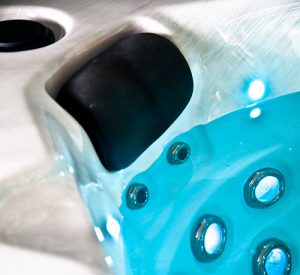Help! My Hot Tub Pillows Stink!

It's a common scenario. You open the hot tub cover and settle in for a warm, relaxing soak. Next thing you know, your senses are bombarded by the overwhelming aroma of smelly hot tub pillows...YUCK! Not relaxing at all! Lucky for you, it’s not too hard to eliminate that stealthy stench.
Why Do My Spa Pillows Stink?
Bacteria, mold and mildew thrive in warm, moist environments, making your hot tub a hot spot for the growth of these smell-inducing microorganisms. Left unchecked, they can accumulate and make your entire hot tub - not just the pillows - smell bad.
It’s easier for microorganisms to grow if the water’s pH is unbalanced and sanitizer levels aren’t high enough. Bacteria can also build up over time if the spa doesn’t get drained and cleaned properly. Failure to remove the spa cover and allow it to breathe or “gas off” regularly can also exacerbate smelly spa issues.
How Do I Clean My Spa Pillows?
Regular cleaning will not only keep your hot tub pillows smelling great, it will also keep them looking great and slow down the rate of deterioration. Here are some quick tips to clean your hot tub pillows and get rid of that stinky smell:
- Remove the pillows from your hot tub. Some pillows are connected by suction cups, some by screws, and some by a specialized plug or clip. Use caution and follow the manufacturer’s instructions so you don’t damage the pillow or attachment pieces.
- Prepare the cleaning solution. If it's part of your regular maintenance, use a gentle hot tub cleansing product. For mild mildew, vinegar and baking soda should do the trick. For more stubborn smells or severe mold and mildew, try bleach and a mild detergent. The use of gloves and safety goggles is recommended when handling strong chemicals.
- Use a sponge and cleaning solution to clean the pillow. Gently scrub to make sure every bit of mold and mildew is removed. If your pillow has a cover or can be disassembled, all pieces should be thoroughly cleaned. For hard-to-reach areas, seams, indents or deep textures, use a toothbrush. Don't scrub too hard, or you'll damage the pillow.
- Rinse pillows thoroughly to remove all cleaning solution.
- Allow the pillows to dry completely. This will kill off any remaining bacteria, mildew or mold spores. Warm, sunny days are perfect for this! Any strong scents left over from the cleaning solution (such as vinegar or bleach) should dissipate as the pillows dry.
- Clean hot tub surfaces in the areas behind the pillows. Don't forget this step! Mold and mildew love to hide and accumulate here, so it could be where the smell was originating.
- Reassemble the fully dried pillows. When you’re ready to use them again, put them back in the hot tub, and enjoy that freshly-cleaned spa pillow scent!
Other Maintenance Tips
Keeping a close eye on water balance, sanitizer levels and overall cleanliness will help your entire hot tub stay looking and smelling good for many years to come. If you start to notice a smell coming from the spa, don’t just mask it with aromatherapy products - those can come after the bad smell is GONE. Find the root of the problem first, and eliminate the cause. Common sources of strong odors include the pillows, biofilm buildup in the plumbing, a dirty filter, an aging spa cover or even the water itself.
For regular pillow maintenance, gently wipe or rinse away chemical residue at least once a week. This is an easy way to prolong the lifespan of the pillows. If you won’t be using the hot tub for a while and are concerned about mildew issues, simply remove the pillows, clean them thoroughly (using the steps above), and store them in a dry place until they’re needed again.
If you notice that your hot tub pillows have started deteriorating and are smelling bad more frequently, it may be time to find replacement pillows.